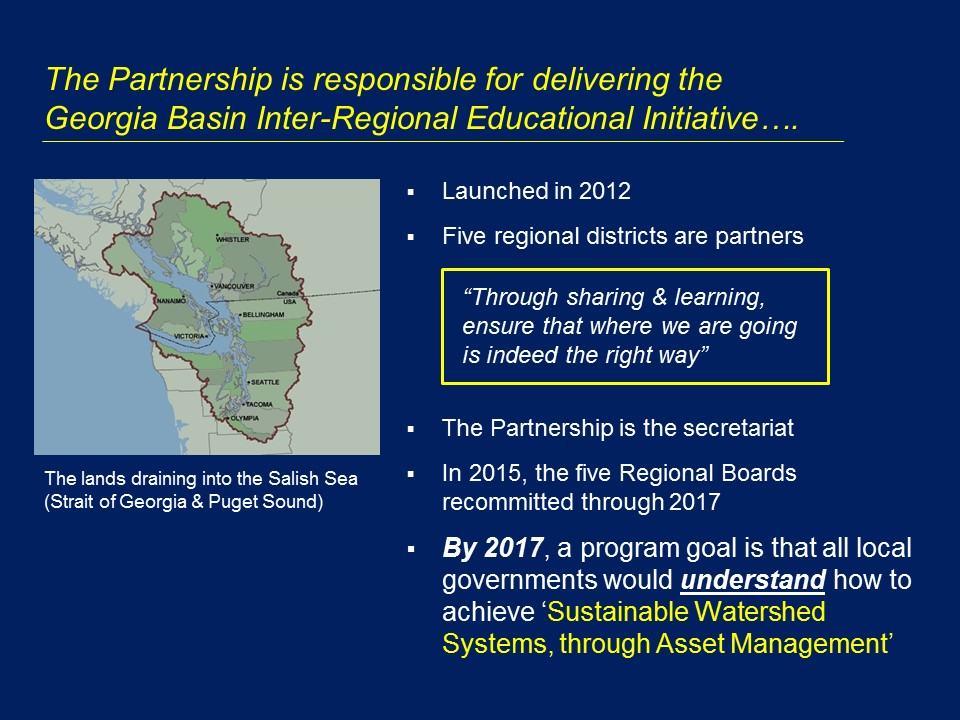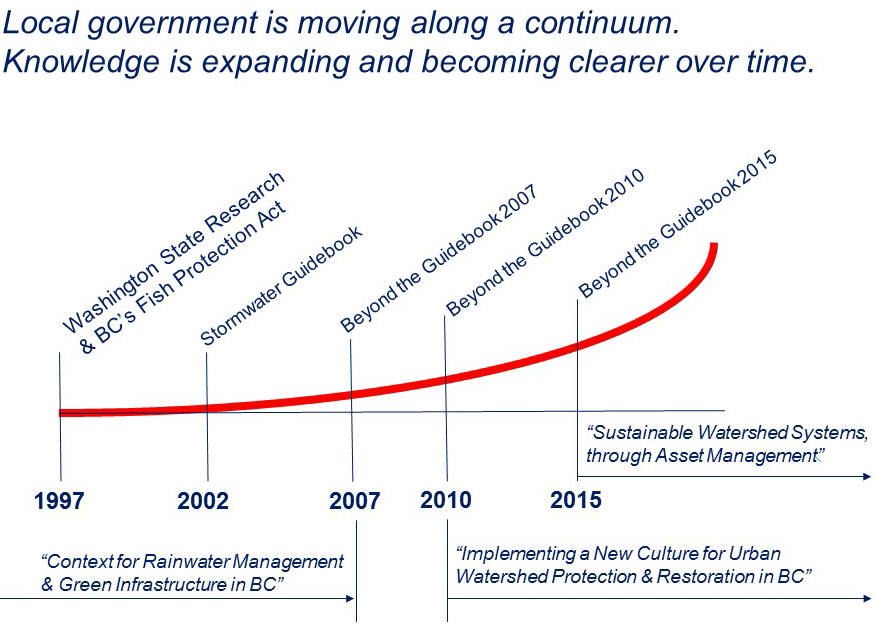Georgia Basin IREI introduced to civil engineering graduates of BCIT (March 2016)
Note to Reader:
In March 2016, the instructor of the Stormwater Management course at BC Institute of Technology in the department of Civil Engineering invited Kim Stephens (Executive Director, Partnership for Water Sustainability in British Columbia) to deliver a guest lecture about Beyond the Guidebook 2015: Moving Towards “Sustainable Watershed Systems, through Asset Management”, a deliverable under the Georgia Basin Inter-Regional Education Initiative (IREI).
Beyond the Guidebook 2015 is a progress report on how local governments are ‘learning by doing’ to implement affordable and effective science-based practices to capture rain where it falls, and to sustain flow in streams.
A Road Map for Water & Watershed Sustainability
“I accepted the invitation to participate in the guest lecture series at BCIT because it created an outreach opportunity in the ongoing rollout of Beyond the Guidebook 2015. I was also impressed by the work that course instructor Laith Furatian was doing to prepare his students for imminent graduation into the working world,” explains Kim Stephens.
 “It was important to see the world through the eyes of his students. So, in consultation with Laith, I designed the lecture as a 2-hour conversation. This meant adapting the lecture content as the conversation unfolded. To help me understand their expectations, at the beginning I asked them about the nature of their interest in hydrology and rainwater management, what has inspired them, and what do they wonder about.”
“It was important to see the world through the eyes of his students. So, in consultation with Laith, I designed the lecture as a 2-hour conversation. This meant adapting the lecture content as the conversation unfolded. To help me understand their expectations, at the beginning I asked them about the nature of their interest in hydrology and rainwater management, what has inspired them, and what do they wonder about.”
“The lecture was built around a PAST-PRESENT-FUTURE unifying theme in order to address three topic areas that emerged from a series of pre-lecture discussions with Laith. We distilled these topic areas down to three bullets: provincial overview, Voodoo Hydrology and ‘change the mentality’. In terms of the FUTURE, it is very much about moving beyond engineered systems to also integrating natural systems. That is the educational goal.”
To Learn More:
To download a PDF copy of the PowerPoint presentation that provided the basis for the guest lecture by Kim Stephens, click on Beyond the Guidebook 2015: Moving Towards “Sustainable Watershed Systems, through Asset Management”.
Lesson Structure
 “The lecture comprised four parts,” continues Kim Stephens. “The objective was to start with a practical sounding topic – rain gardens – that the students could visualize. It was important that these graduating engineers realize that a rain garden is more than just ‘gardening’. With this starting point, it was then a matter of delving into the details in order to introduce the science behind the Water Balance Methodology that generates performance targets for sizing of rain gardens.”
“The lecture comprised four parts,” continues Kim Stephens. “The objective was to start with a practical sounding topic – rain gardens – that the students could visualize. It was important that these graduating engineers realize that a rain garden is more than just ‘gardening’. With this starting point, it was then a matter of delving into the details in order to introduce the science behind the Water Balance Methodology that generates performance targets for sizing of rain gardens.”
Voodoo Hydrology
 “The last part of the lecture introduced the students to Voodoo Hydrology, a term that humourist Andy Reese coined in 2006. A frustration among hydrologists is the misapplication of science that one sees all the time in the practice of drainage engineering and stormwater management. One of Andy’s quotable quotes provided a backdrop for assumptions that may drive the design process, but do not hold up under scrutiny. The purpose was to provide students with food for thought.”
“The last part of the lecture introduced the students to Voodoo Hydrology, a term that humourist Andy Reese coined in 2006. A frustration among hydrologists is the misapplication of science that one sees all the time in the practice of drainage engineering and stormwater management. One of Andy’s quotable quotes provided a backdrop for assumptions that may drive the design process, but do not hold up under scrutiny. The purpose was to provide students with food for thought.”
“ The presentation by Kim Stephens gave further insight into how thinking has evolved regarding stormwater management in our region and elsewhere. His discussion of Voodoo Hydrology reinforced the importance of questioning everything, a habit I try to encourage in my students,” comments Laith Furatian.
The presentation by Kim Stephens gave further insight into how thinking has evolved regarding stormwater management in our region and elsewhere. His discussion of Voodoo Hydrology reinforced the importance of questioning everything, a habit I try to encourage in my students,” comments Laith Furatian.
To Learn More:
For background on the origin of the term “voodoo hydrology”, click on Voodoo Hydrology Annual Webinar Series (January 2016): “The rise of Green Infrastructure and Resilience Planning opens the door for newer Voodoo like never before,” observes Andy Reese, water resources engineer and author
Moving Along the “Beyond the Guidebook” Continuum
“For the purposes of the lecture, and in order to provide the students with context, I introduced them to the notion of a continuum,” explains Kim Stephens. “My objective was to impart a simple message, and that is – knowledge, and our understanding of what that knowledge means, is expanding and becoming clearer over time.”
“Beyond the Guidebook 2015 is the third in a series. It builds on the foundation provided by Stormwater Planning: A Guidebook for British Columbia, released by the Province in 2002. It is a snapshot in time. Local government leaders have made substantial progress since 2002, and Beyond the Guidebook 2015 showcases and celebrates five “regional stories” as told in the words of the champions in each region – Metro Vancouver, Capital Region, Cowichan Valley, Nanaimo Region and the Comox Valley.”
Genesis for Water Balance Methodology
“ The ‘salmon crisis’ throughout the 1990s decade galvanized awareness in BC that the ecological baseline was shifting, suddenly and dramatically. The ecosystem value of small, headwater streams had not been fully appreciated. The result: streams were being lost as a consequence of rapid population growth and land development.”
The ‘salmon crisis’ throughout the 1990s decade galvanized awareness in BC that the ecological baseline was shifting, suddenly and dramatically. The ecosystem value of small, headwater streams had not been fully appreciated. The result: streams were being lost as a consequence of rapid population growth and land development.”
“In response, governments recognized the need to restore and protect watershed and stream health. This was the genesis for the Water Balance Methodology. This set in motion a chain of actions and events. The ripple effects are reverberating through time.”
Restore Water Balance to Re-Set Ecological Baseline
“By 2002, looking at rainfall differently led the Province to adopt the Water Balance Methodology as the technical foundation for Stormwater Planning Guidebook, initiate a performance target approach to capturing rain where it falls, and initiate changes in the way rainwater runoff is returned to streams.”
“The Guidebook vision is that community development activities and further alteration of the Built Environment will result in cumulative benefits, not impacts. In 2002, the Guidebook identified a path forward for local governments,” emphasized Kim Stephens.







